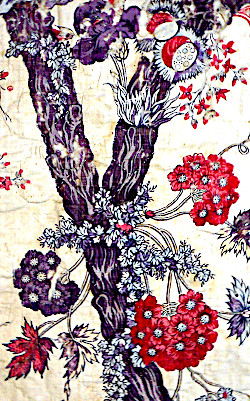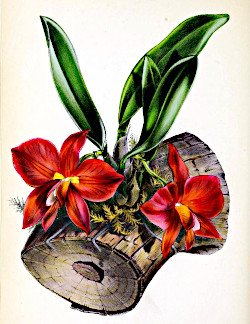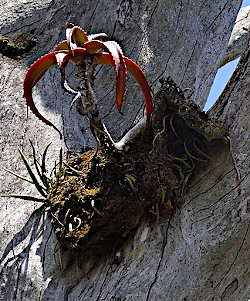Floral Motifs on Early Chintz
Epiphyte - A Nonparasitic Plant Growing on Another Plant



Epiphytic orchid Sophrontis grandiflora from Sir Joseph Paxton, Paxton's Magazine of Botany, and Register of Flowering Plants, vol. 9, facing p. 193, 1842
Epiphyte plants including Aloe sp. on a dead tree photo by Ton Rulkens from Mozambique, CC BY-SA 2.0 <https://creativecommons.org/licenses/by-sa/2.0>, via Wikimedia Commons
Epiphyte from the Private Collection, Flowers of India on a Trunk, Manufactured by Hartmann et Fils, Munster, France, c. 1800
Common Names: Epiphyte
Description: Epiphytes are nonparasitic plants that grow on other plants for support. They get their moisture and nutrients from the air as well as the leaf litter and other debris that collect around them. The term describes a growth habit that may occur in a wide range of plants rather than a specific taxonomic group. Lichens, ferns, liverworts, mosses, and algae as well as a wide variety of flowering plants including bromeliads and orchids can be epiphytic (i.e. can grow in this manner). The tree trunk on the pictured textile shows several different plants growing epiphytically on it. Because most of the plants are so stylized as not to be identifiable, the growth habit is identified rather than the plants themselves. This piece clearly shows the plants growing on the tree trunk rather than the much more typical "Tree of Life" motif which shows a variety of plants sprouting from the tree trunk.
Quilts with this Epiphyte motif:
Chintz with this Epiphyte motif:
Description: Epiphytes are nonparasitic plants that grow on other plants for support. They get their moisture and nutrients from the air as well as the leaf litter and other debris that collect around them. The term describes a growth habit that may occur in a wide range of plants rather than a specific taxonomic group. Lichens, ferns, liverworts, mosses, and algae as well as a wide variety of flowering plants including bromeliads and orchids can be epiphytic (i.e. can grow in this manner). The tree trunk on the pictured textile shows several different plants growing epiphytically on it. Because most of the plants are so stylized as not to be identifiable, the growth habit is identified rather than the plants themselves. This piece clearly shows the plants growing on the tree trunk rather than the much more typical "Tree of Life" motif which shows a variety of plants sprouting from the tree trunk.
Quilts with this Epiphyte motif:
- None known at this time.
Chintz with this Epiphyte motif:
- Private Collection, Flowers of India on a Trunk, Manufactured by Hartmann et Fils, Munster, France, c. 1800
- The Victoria and Albert Museum, Flowers of India on a Trunk, Manufactured by Hartmann et Fils, Munster, France, Object Number T.202-1919, Toiles de Jouy: French Printed Cottons 1760-1830, p. 31, c. 1800
© Updated 4/10/2022 Author: Terry Terrell